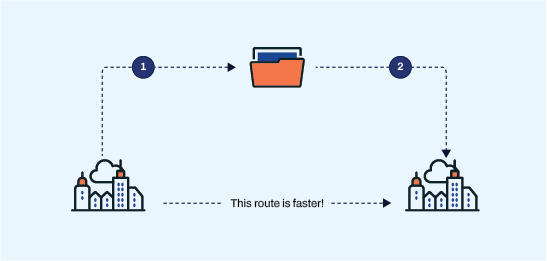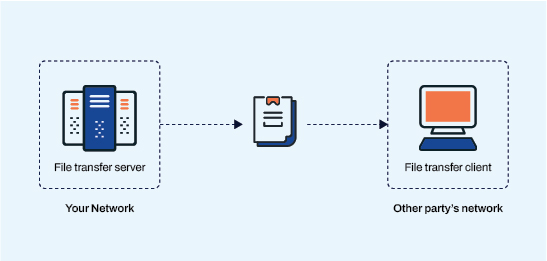When your business processes involve large files that need to cross the internet in the fastest way possible, look beyond traditional methods like email or cloud-based file sharing services. These methods fall short of meeting certain business requirements for time-sensitive large file transfers. In many cases, your best option would be a managed file transfer (MFT) solution.
Before we discuss the limitations of these traditional methods and why an MFT solution is best suited for the task at hand, let’s talk about some relevant use cases. These are different business-related scenarios that require fast, large file transfers.
Sample use cases for time-sensitive large file transfers
Video production and distribution
Companies in the film industry are quite familiar with this big data transfer problem. Post-production outfits often work with large video files to apply editing, special effects, musical scores, etc. To say that these files are massive is an understatement. For instance, it’s not uncommon for a 1-hour 4K video to reach between 1.5–3 terabytes in size. Once the files are ready, they often need to be sent to broadcasters, streaming services and other associates in the industry.
In order to meet release dates and broadcast schedules, it’s important for these files to arrive at their destination in the quickest time possible. If a video file’s next stop is located across the country or across the globe, it’s only logical to send the file through the Internet.
Medical imaging and telemedicine
Hospitals sometimes send large medical imaging files, such as MRIs and CT scans, to specialists for diagnosis or second opinions. Since prompt treatment is vital to patient care, it’s important for those files to reach their destination as fast as possible. If a specialist is located in a distant city or country, it makes sense to send those files through the Internet.
Other sample use cases include:
- CAD files and project designs produced by an engineering firm for a client working under a tight project schedule
- High-resolution promotional materials that need to be distributed by marketing firms to various media outlets before a fast-approaching launch date
- Large datasets that have to be shared by a scientific research firm with a collaborator on the heels of an impending grant submission deadline
I’m sure you’re accustomed to sending files through email. So, you must be wondering why you can’t use email for this purpose.
Why email and big files don’t match
Email is meant for exchanging messages, not sending big files. Email providers lack the capacity to store large files. That’s why, even if they allow email attachments, providers set size limits for those attachments. In Gmail, for example, the file size limit is 25 MB. If your file is larger than 25 MB, you’ll have to use Google Drive.
Not all email providers have an affiliated cloud storage service like Google Drive. So, once your file exceeds the limit, you can’t attach it anymore. Another reason email providers limit file sizes is because larger files consume more network bandwidth. A congested network can adversely affect the overall performance of the email service and the customer user experience.
How much can file compression help?
One way to work around the file size limitations imposed by email providers is to apply file compression. When you compress files before attaching them to your email, they won’t occupy as much space as they normally would on your mail server’s hard drive. Not only that, but they also won’t consume as much network bandwidth. File compression, therefore, allows you to make more efficient use of your internet connection.
File compression functionality is easily accessible, as it’s supported by all major operating systems. For instance, you can create a zip file on Windows, Linux or Mac computers without installing any additional software.
That said, not all files can be compressed significantly. You can compress documents, spreadsheets and various text files to a small fraction of their original size. However, image, video and audio files are already compressed. Any attempt to compress these files further will only yield minimal results. So, if you’re trying to send a large media file through email, file compression may be =ineffective.
Will file sharing services like Dropbox and Google Drive suffice?
Another popular option for sending large files through the Internet is the use of cloud file sharing or cloud storage services. You can upload files to cloud services like Microsoft OneDrive, Google Drive, Dropbox, Box or WeTransfer and then share them with your intended recipient through a download link or similar mechanism. Some services allow you to secure shared links with password protection and expiration dates, which minimize the risk of unauthorized access.
Most, if not all, of these cloud services can be accessed from web browsers. Meaning, you can upload and download large files from almost any device. Some of these services even offer mobile apps for Android and iOS, giving you even more flexibility in sending or receiving large files, provided your device has the storage capacity to support them.
Cloud storage providers offer generous amounts of storage space, so you don’t have to worry about capacity. Moreover, if you need more space, these providers allow you to increase your allocation through flexible pricing plans.
So, what’s the caveat?
Well, for one, some of these services have upload limits. Unless you’re using a free account, the storage capacities are practically unlimited. However, their upload limits aren’t. For example, in Box, the largest file you can upload is 150 GB. So, if you want to upload, say, a 500 GB file, you’ll need to find a way to split it into smaller files.
Secondly, these services aren’t exactly the fastest for sending files. You must first upload your files to the cloud service, and then the receiving party has to download them. This two-step process isn’t optimal. The files have to travel a longer distance to reach their destination compared to direct methods like the ones we’re about to discuss.

How about FTP and other traditional file transfer solutions?
The fastest way to transfer large files through the Internet is to use a method that doesn’t have to route your files through a middleman. When you use a cloud-based service, that service acts as a middleman. It results in the lengthy two-step process we described earlier.
But how can you send a file directly to your intended recipient? You can use two endpoints that communicate through a shared file transfer service protocol, like standard File Transfer Protocol (FTP) or Secure File Transfer Protocol (SFTP). One endpoint must be stationed at your end, and the other endpoint at the receiving party’s end.
This setup can have multiple variations. For example, if you’re using SFTP, one variation is to have an SFTP client running in your network and an SFTP server running in your recipient’s network. You can then use your SFTP client to upload files to your recipient’s SFTP server.

Another variation is to have an SFTP server running in your network and an SFTP client running in the other party’s network. That other party can then retrieve files you wish to share from your server using its SFTP client.

In any of these setups, the files are transferred directly from sender to recipient, resulting in shorter total transfer times.
All major operating systems, including Windows, Linux and mac OS have built-in file transfer applications that support either FTP or SFTP. In addition, you can easily download free and open-source file transfer applications like FileZilla, WinSCP and Cyberduck in case you need to. Most of the tools you need are easily accessible.
It’s worth noting that FTP is an unencrypted protocol. Unlike SFTP, it lacks the needed security mechanisms that protect file transfers from network-based hackers. If you have to use FTP, we suggest you run your FTP connections through a virtual private network (VPN). That VPN will provide the encryption functionality needed to thwart would-be attackers.
Basic file transfer applications that use protocols like FTP or SFTP are fast enough to enable time-sensitive large file transfers. However, they’re not your best option if you’re conducting these file transfers as part of an overarching business process, like in the sample use cases outlined earlier.
Why you should transfer large files via an MFT solution
When you set out to transfer large files as part of a time-sensitive business process, your requirements for accomplishing this task go beyond speed and moving files from point A to point B. You must also take into account additional factors like:
- Automation and integration
- Data security and compliance
- Reliability and resilience
- Visibility and control
MFT solutions enable you to transfer large files directly from the sending party to the receiving party and are more capable of meeting business requirements than any of the other solutions mentioned above.
Automation and integration
In a business environment, most file transfers aren’t standalone activities. They’re usually part of an overarching business process. To streamline these processes, you’d want to automate every workflow that can be automated. MFT solutions normally come with automation features that enable you to integrate an MFT solution with other business applications and build automated workflows. Once you combine automated workflows with fast file transfers, you’ll be in a better position to support time-sensitive business processes.
Data security and compliance
In many industries, file transfer workflows are subject to strict regulatory compliance requirements. In healthcare, for instance, you’re supposed to comply with Healthcare Portability and Accountability Act (HIPAA) mandates. Unlike the other solutions mentioned, an MFT solution is backed by a comprehensive array of security features that help achieve various data privacy and data protection regulations.
Reliability and resilience
Large file transfers take time to complete. While in progress, these activities tend to consume loads of computing resources. As a result, they increase the risk of downtime and file transfer failure due to system overload. Enterprise-grade MFT solutions like JSCAPE MFT Server by Redwood are equipped with high availability (HA) features that prevent overloads. Instead, they enable seamless and uninterrupted file transfers at all times.
Visibility and control
When you have many file transfers going on at the same time, it’s ideal to have complete visibility and control. These abilities allow you to spot issues and resolve them before they get worse. MFT solutions typically provide a centralized administrative interface. So, from a single pane of glass, you can track and manage all your file transfer activities.
Experience fast large file transfers with JSCAPE MFT
JSCAPE MFT provides security, compliance, reliability, resilience, visibility and control in one solution. That said, it’s best to experience all those benefits firsthand. Book a JSCAPE free trial now.





